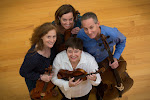Many of you have likely heard by now about our new Quartet-in-Residence position at the University of Delaware, the school where I also teach as Associate Professor of Cello. We're very excited about the honor and the opportunity (we start Monday!), and I thought I'd share a bit about what we'll be doing.
While some groups take a residency position strictly to have a home base to perform and rehearse, SSQ's aim is to be as important a part of the community for students as we can be. Of course, we'll also be at the UD Music Department as a home base, and will be doing rehearsals there every week and giving some concerts, but we see our function as to help enhance the experience for the music students, particularly the string players.
In addition to rehearsing on our days at UD (most every Monday with some other days sprinkled in throughout the year), we'll be working with student chamber ensembles, presenting "informances" in the Music Department and at other venues on the campus, and collaborating with other faculty. Just a few things in our first two weeks of the residency!:
- We'll be hearing orchestra and chamber music auditions this coming Monday, to help place students in chamber groups that will hopefully thrive.
- On September 10th, during the Department's General Student Recital (a weekly Music Student Convocation), we'll formally introduce ourselves to the student body, performing some of the repertoire from our upcoming season, including a movement of the Brahms Clarinet Quintet with wonderful clarinetist and UD faculty member Marianne Gythfeldt.
- On September 13th and 15th, we'll be giving string sectionals to the students in the UD Symphony Orchestra.
- Also on the 15th, we'll be presenting the inaugural lunchtime concert for a series at UD's Institute for Global Studies, in a lovely little building that was built before 1775!
So, we're starting off with a bang, and are looking forward to even more interaction with the students, faculty and patrons of the entire university. There's a lot planned for the year, and we'll keep you posted.
We're very thankful to the University of Delaware's Department of Music and its chair, Paul Head, who helped facilitate all of this with the generous assistance of an outside donor. SSQ is hopeful that this will be a relationship that can grow and prosper as the years go by.
One concern we have, however, and that I have had to battle with (as a faculty member for 6 years now), is the school's mascot. If you don't know, Delaware is known as the Fightin' Blue Hens (an honorific back in Revolutionary days for someone who was tough and fierce). That's all well and good, but "YouDee", our particular Fightin' Blue Hen mascot, looks like this:







